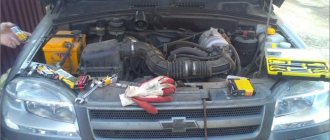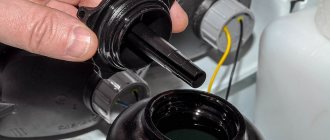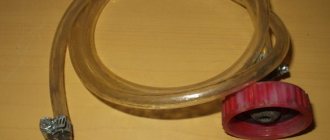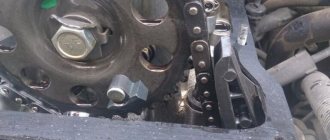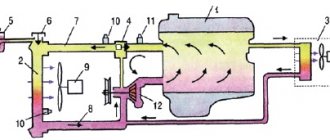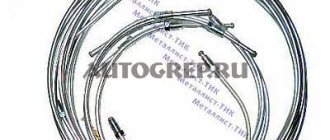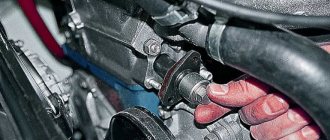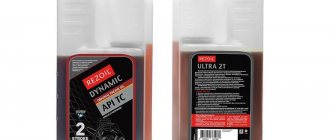At the moment, almost all modern car models are equipped with power steering. It allows you to simplify wheelbase control and make it easier. This is especially true for a car like the Chevrolet Niva, which belongs to the SUV class. The Niva's mass is one and a half tons, and in off-road conditions it is required that the wheels react sharply to turning the steering wheel. In such conditions, there is an increased load on the steering, which is fraught with breakdowns, which may result in a leak. If the level in the expansion tank drops at the slightest level, you must immediately add fluid to the Niva Chevrolet. You can do this yourself, without visiting a service station.
Also, the need to add fluid to the steering wheel on a Chevrolet Niva can be determined by its external condition. It is believed that the power steering is refilled once by the manufacturer and does not require replacement during further operation. But if there is damage to the steering rack, oil and dirt may enter the system. As a result, traces of contamination can be seen in the expansion tank. Also, power steering fluid, like all fractional mixtures, can form a sediment of components over time, which affects its quality and requires replacement. In practice, it is necessary to change it every six years, regardless of its condition, since the temperature difference between winter and summer negatively affects its condition.
Operating principle of power steering
The operation of the hydraulic booster is based on the transmission of pressure by liquid. This pressure can exert forces on parts of the steering mechanism, thereby reducing steering effort. The entire design of the power steering is aimed at creating high pressure in the fluid. This pressure is created in the working line, which opens when the steering wheel is turned. The force is transmitted to the hydraulic cylinder of the steering rack or steering mechanism, and then to the steering rods. As a result of the power steering, the driver feels barely noticeable resistance on the steering wheel, which allows you to control the car in difficult road conditions.
Story
I have already said many times that I do not do tuning or modifications for the sake of the process. Only if there are problems. In this case, it all started with the “collective farmers” of AvtoVAZ. For a very long time, the plant installed German ZF power steering pumps on the assembly line, and then suddenly the Russian version came into use. As usual, the plant was not going to give any explanations, so I had to turn to another source, the manufacturer ZF. A technical seminar organized by this company was held in St. Petersburg, and I asked the German a question about this situation. Directly at the lecture (that is, the official position), the German specialist said that this is a trade secret. And during the lunch break, when I addressed him in German, he straightened up and said the following. Quote. Along with the supply of pumps, we gave a recommendation to AvtoVAZ on what SHOULD be poured into the system. At first, the plant filled it with an approximate analogue of the liquid that we recommended, and then suddenly it started pouring green Pentosin. The result was not long in coming - leaks and a humming sound when turning. But the funny thing is that all these “supposedly” warranty cases were transferred to the shoulders of ZF. The German said that we “butted heads” with the plant a little, did not get clear answers from the managers and management and simply stopped supplying this spare part. End of quote. Now we come to a simple conclusion: in order to get a working unit, as intended by the designers, we need to flush the system and fill it with what is recommended. The fluid is simple, good synthetic dextron, but along with it I recommend replacing the low pressure hoses.
Power steering pump
The power steering pump can be called the main unit, since it is it that pumps fluid, creating increased pressure in the line. The main element of the pump is the impeller, which is driven into rotation by a belt drive. Unfortunately, many power steering malfunctions are associated precisely with pump failure. Liquid starvation is unacceptable.
The driver must carefully monitor the fluid level, since air entering the pump leads to accelerated wear.
The presence of air can be recognized by a sudden increase in the force on the steering wheel, as well as a characteristic buzzing sound when turning the steering wheel. Bleeding the line is a standard procedure and is carried out by turning the steering wheel in one direction or the other.
The next problem is wear of the shaft bearing. The fact that the bearing has become unusable is indicated by extraneous sounds emitted from the pump when the engine is running. To verify this, just remove the drive belt and start the car. If the sounds disappeared, then the reason was in the pump. The situation can be corrected by replacing the shaft bearing.
Answers (3)
There are two ways to replace the fluid in the Chevrolet Niva power steering: To partially replace the power steering oil, you will need a syringe with a tube and the oil itself, enough so that at the end of the work it will no longer be dark. Loosen the clamp securing the outlet hose and remove the hose.
To prevent fluid from leaking, plug the hole in the tank fitting and lower the end of the outlet hose into a container for drained fluid. Start the engine and, turning the steering wheel from lock to lock in both directions three or four times, drain the old fluid while adding new fluid.
Repeat the operation until fresh fluid appears from the outlet hose.
Carefully monitor the fluid level in the reservoir and do not allow air to enter the power steering pump. This may damage the pump. Install the tank in the reverse order of removal.
Add fluid to the level of the upper mark on the dipstick of the reservoir plug. Bleeding the power steering system The need for bleeding occurs when air enters the hydraulic system during repair work or when it loses its tightness during operation.
Rotary valve
High pressure in the line must be controlled, otherwise the fluid will exert force in only one direction. A rotary valve is used to distribute the liquid along the line. To be more precise, there are several of them. When the steering wheel is turned, the valve opens that part of the line that corresponds to the given direction of movement of the rack rod. Usually, throughout the entire period of operation, the valve does not cause any problems, but for this it is necessary to periodically change the power steering fluid according to the established regulations, otherwise the valve may become clogged.
What does that require
First of all, you need to determine the brand of the liquid. This can be of two types. Pentosin Hidraulik Fluid CHF11S and Shell Donax TA D-21631 (Dexron 2). Penozin. it's a green liquid. And Dexron is red. Dexron is interchangeable with Ravenol Dexron 2 D.
In general, there are special symbols on the fluid reservoir, which is located on the back of the engine compartment next to the battery. Therefore, if Dexron 2 D is poured into the tank, it is an "R". And if the icon is “,” then this is Dexron 2. Under no circumstances should Pentosin and Dexron be mixed. After washing, only complete replacement is possible.
Steering gear
The steering mechanism performs two functions simultaneously. First, it converts steering wheel rotation force into bipod rotation force. In essence, the rotation axes rotate. Hydraulic fluid transmits force to a power cylinder connected to the bipod sector. The most common malfunction of the mechanism is associated with a leak in the high pressure line connection fitting. Typically, repairs come down to replacing the fitting along with the main hose.
The power steering can serve properly for a long time.
The main requirement is to change the fluid in a timely manner and monitor the tightness of the system.
Bleeding the power steering system of Niva Chevrolet (VAZ 2123)
Bleeding the power steering system is necessary when replacing fluid, as well as to remove air that has entered the hydraulic drive when repairing or replacing individual components of the system. To bleed the hydraulic system, open the power steering reservoir cap and add fluid to the lower mark on the reservoir cap indicator. We start the engine and at idle speed check the fluid level in the tank. If the liquid level drops, add it to the lower mark. We turn the steering wheel left and right several times until it stops, making sure that the fluid level in the tank is at the lower mark. Remove the protective rubber cap from the bleeder fitting.
The bleeder fitting is located on the steering gear cover.
We put a transparent hose on the head of the fitting, lowering its free end into the vessel. Using the “8” wrench, unscrew the fitting 1/2 turn. When a continuous stream of liquid appears in the hose, tighten the fitting. We return the steered wheels to the straight-line position of the car and let the engine run for another two to three minutes. Normal operation of the hydraulic booster should not be accompanied by noise. Turn the steering wheel all the way left and right again and, if necessary, add fluid to the tank to the bottom mark. After warming up and stabilizing the temperature of the working fluid, its level should be at the upper level, and in a cold state not fall below the minimum level.
Chevrolet Niva & | Replacement of outer tie rod end & | Chevrolet Niva
Replacing
admin
If necessary, use a wrench to keep the rod from turning beyond the edge of the adjusting bolt shown by the arrow.
Removing the steering tip without a puller and replacing the boot in 10 minutes. Steering rod VAZ NIVA
The cotter pin of the outer hinge pin is removed and its nut is unscrewed.
Chevrolet Niva OLIVKA › Logbook › Replacing tie rod ends. It's time to change the factory tips...
To do this, you need to unscrew the four mounting nuts. Carry out restoration of steering rods, replacing worn out hinge mechanisms. Replacement can be carried out either independently in the garage or at a service station.
In this case, you can use a hammer, striking the end of the lever boss accordingly. The puller is installed and the hinge pin is removed from the swing arm.
Another puller option The front wheel is removed, requiring replacement of the part.
The cotter pin of the outer hinge pin is removed and its nut is unscrewed. A puller is installed and the hinge pin is removed from the swing arm.
The video below shows how to properly press out a finger with a puller. There is no need to purchase a puller to remove the hinge pin.
In this case, you can use a hammer, striking the end of the lever boss accordingly. The cotter pin is removed from the inner joint nut, after which the nut is unscrewed and removed. Using the same puller, you need to press out the ball joint pin of the tip.
The steering rod is removed and replaced with a new one. Installation of the rod is carried out in the reverse order of removal.
Replacing steering tips and rods on a VAZ 2121 field
Replacing the middle link You will need: Replacing the middle link is shown using the example of disconnecting the ball joint from the bipod of the steering mechanism. Disconnect the rod from the pendulum arm in the same way.
Press the lateral link ball joint pin out of the bipod of the steering mechanism, see. Removal of the lateral link is hampered by the front axle gearbox housing. The rod ball joint pins cannot be completely removed from the eyes of the bipod and the pendulum arm.
Therefore, disconnect the front axle gearbox from the stabilizer by unscrewing the four nuts securing the stabilizer brackets to the gearbox housing. Under its own weight, the gearbox will rotate on the front supports, and a gap will open between it and the rod, sufficient to remove the rod.
see also
Characteristics of Dextron 2 and 3 - what are the differences
- 38 1 29k
Power steering malfunctions
- 22 0 33k
What kind of oil to fill in power steering
- 160 0 214k
Power steering buzzes
- 360 7 331k
15 best power steering fluids
- 122 13 371k
Bleeding the power steering and its system is carried out when replacing the working fluid, airing, which may be the result of a malfunction or repair work. Air trapped inside not only reduces the efficiency of the power steering, but can also cause serious damage, in particular, failure of the power steering pump. Therefore, pumping the hydraulic booster must be carried out in strict accordance with existing technology.
Removal
Over time, the power steering wears out or breaks, so it needs to be replaced, but to do this it needs to be removed, this can be done as follows:
- The first step is to remove the belt that drives the power steering, as well as the protection of the pan with mud flaps of the engine compartment.
- We pump out all the liquid from the tank
- We take a screwdriver and stop the pulley, loosen the bolts that secure it to the flange
- Unscrew all the bolts and remove the pulley
- Drain the remaining liquid
- Disconnect the hose
- Unscrew the bolt fitting
- Seal the hose tip with a special washer
- We unscrew all the existing fasteners, including the top bolt, and remove the pump.
After the pump is removed, it can be repaired.
How to pump power steering
How to fill oil and bleed power steering
The procedure for replacing fluid and pumping power steering is carried out in strict accordance with the existing algorithm. Some automakers may add their own features to it. If you have a manual for your car, we recommend that you read the relevant section. In general terms, the steps must be performed in the following sequence:
- Raise the vehicle completely on a lift or with the front wheels off the ground.
- If necessary, drain the old fluid from the expansion tank. To do this, remove the return hose (going to the power steering system) from the expansion tank and put a plug on it so that liquid does not spill out of the hose. A hose leading to an empty bottle is connected to the released tap on the tank, where the old hydraulic fluid is supposed to be drained.
- It is most convenient to pump out the main volume of liquid with a syringe and pour it into a separate bottle. When there is very little liquid left, move on to the next point.
- Fill the expansion tank with working fluid to the top.
- Next, you should turn the steering wheel from side to side (from lock to lock) several times so that the old fluid remaining in the system flows out through the hose. Since the new fluid displaces the old, do not forget to monitor the oil level in the tank so that air does not get into the hose.
- If the fluid level drops, add it again.
- Start the engine for 2-3 seconds and turn it off. This is done so that the liquid begins to spread throughout the system.
Pumping out oil with a syringe
- Next, add working fluid to the tank to the MAX level and repeat the procedure by starting the engine. Repeat this cycle 3-5 times.
- The signal to stop pumping is the fact that air from the return hose stops entering the drain bottle. This means that there is no more air left in the hydraulic system and fresh, clean fluid enters the reservoir.
- After this, you need to reinstall the return hose (connect it to the expansion tank where it was originally installed).
- Refill the reservoir to the MAX level, then start the engine.
- To pump the hydraulic booster, you need to slowly turn the steering wheel 4-5 times from the left to the right stop. At the stop points, pause for 2-3 seconds. If there is any air left, it should escape into the expansion tank. During the inspection process, we make sure that the pump does not make any extraneous noise.
- An indicator that pumping has ended will be the absence of air bubbles on the surface of the liquid in the tank.
- After this, close the expansion tank tightly.
Bleeding the power steering system
can also be pumped without starting the engine , “cold”. To do this, just rotate the steering wheel from the left to the right stop . At the same time, old fluid and air leave the system. However, most automakers still recommend bleeding the system with the engine running.
Step-by-step process of draining the old fluid and adding new one
In order for the power steering system to work properly, it is necessary to completely replace the power steering fluid every 3 years. The procedure is as follows:
- Raise the front wheels of the car on a jack so that no pressure is exerted on them;
- Open the hood and secure it;
- Remove the power steering reservoir cap and remove the filter located inside;
- Clean the filter from dirt and deposits using a special product;
- Next, pump out the old solution from the tank using a syringe;
- The hoses are disconnected, the contents are poured into an empty container;
- Start the car engine and turn the steering wheel several times;
- After all the fluid has been removed from the power steering, you can begin to fill in new oil.
After the oil is poured into the expansion tank to the maximum mark, it is necessary to distribute the mixture throughout the entire power steering system. To do this, the steering wheel is turned all the way to the right and left. The oil level will drop at this moment. If necessary, add liquid.
Typical power steering malfunctions
Malfunctions in the operation of the hydraulic booster can be easily identified by characteristic signs. Among them:
- The steering wheel turns hard . Probable causes are failure of the power steering pump, use of unsuitable working fluid, sticking of the spool mechanism channels.
- , a high-frequency sound (similar to a whistle) is heard while driving The probable cause is a loose drive belt.
- The steering wheel turns jerkily . Probable causes of the malfunction are the working fluid not meeting the specifications declared by the manufacturer, a malfunction of the fluid distributing mechanism, or a pump malfunction.
- The presence of intense foaming in the expansion tank. Probable causes are mixing of different types of fluids, failure of the power steering pump.
- When the engine is running, the steering wheel spontaneously turns in any direction . The probable cause is malfunction of the spool mechanism, most often, clogging of its working channels, incorrect assembly (for example, after installing a repair kit).
Recommendations for operation and maintenance of power steering
In order for the power steering and its system to operate normally, as well as to extend their service life, you must adhere to several simple rules:
- use working fluids recommended by the automaker , and also replace them in a timely manner (most automakers recommend replacing power steering fluid every 60.120 thousand kilometers, or once every 2 years, it depends on the driving style and intensity of use of the car);
- carry out bleeding of the power steering system in strict accordance with the algorithm described above (or observing individual requirements, if any are set by the car manufacturer);
- monitor the condition of the steering rack boot , because if it is torn, dust and dirt will enter the system, which leads to the power steering pump exiting. A sign of a problem that has already occurred is the hum of the power steering, which is not eliminated even by replacing the fluid.
Cost of replacing fluid and pumping power steering
If you plan to carry out work on replacing the fluid and pumping the power steering yourself, then you will only need to buy oil in a volume of 1 to 3 liters (including flushing, while the volume of the power steering system of a passenger car is up to 1 liter). The price of the liquid depends on the brand and store. It is within $4.15 per liter. If you do not want or cannot carry out such work yourself, contact a service station for help. Approximate prices for January 2021 are:
- fluid replacement work - 1200 rubles;
- power steering pumping - 600 rubles.
Signs of trouble
On the Internet you can find many different videos and materials that discuss the issue of airing and problems in the power steering on cars of different types, classes and sizes.
Therefore, do not be surprised if you come across questions regarding power steering pumping:
- on KAMAZ;
- on Shakman;
- ZIL 130;
- on the Volga (GAZ 31105);
- in Scania;
- Toyota Corolla;
- Nissan Qashqai;
- Lada Priora;
- Renault Symbol;
- Ford Focus;
- Niva Chevrolet;
- Volkswagen Passat B3;
- Toyota Avensis;
- Skoda Octavia;
- Renault Logan, etc.
The automotive power steering system can become airy for reasons already stated, related to breakdowns, or structural interference in the power steering.
At the same time, every driver is recommended to be aware of the characteristic signs indicating the fact that the system is air-filled. It is when they appear that mandatory pumping is required.
There is nothing difficult in diagnosing and detecting the problem. Look for the appearance of one or several signs indicated in the list:
- there is a strong noise near the power steering itself;
- strong extraneous noise may come from the power steering pump;
- there is a clear increase in pressure on the steering wheel;
- the steering wheel becomes harder to turn during maneuvers;
- leakage of working fluid is observed from the system;
- foam appears on the surface in the expansion tank with hydraulic fluid;
- The steering wheel rotates spontaneously in different directions.
Previous posts from the category: NIVA CHEVROLLE
Fuel pump design The Chevrolet Niva fuel pump is located in a gas tank and is combined into a common module with a fuel pressure regulator and a gasoline level indicator. The electric submersible pump has a commutator motor.
Changing the chain tensioner on a Chevrolet Niva
Hydraulic Chain Tensioner The chain tensioner is one of the parts of the gas distribution system that relates to the engine camshaft. It is located in front of the “head” of the cylinder block under the cooling system nozzle.


